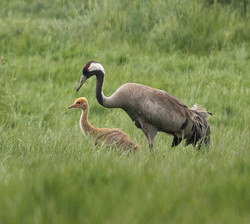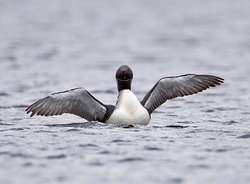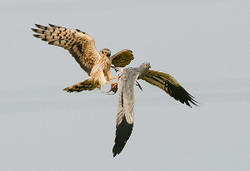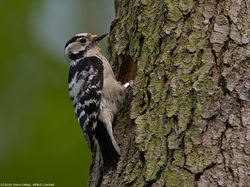The RSPB is warning that some of Scotland’s globally important seabird colonies could become extinct if the Scottish government does not act quickly. Species like Common Guillemot, Razorbill and Puffin are struggling to cope with increasing challenges including lack of food and the effects of climate change, leaving Scotland’s once bustling 'seabird cities' in danger of failing entirely. The RSPB's warning comes after end-of-season counts at its coastal reserves revealed that these species are continuing to experience severe long-term declines. Recent reports that numbers had stabilised now appear to have been premature. Recent counts carried out at Noup Cliffs RSPB, Orkney, reveal a 41 per cent fall in numbers of Common Guillemot since the last census in 2000. Dunnet Head RSPB on the Caithness coast saw a decline of around 45 per cent, from 8,980 to just 4,880 birds, since 2000, while Common Guillemots on Ailsa Craig RSPB in the Firth of Clyde have suffered a decline of over 27 per cent. The charity is calling on the Scottish government to urgently designate Marine Protected Areas (MPAs) for the country’s seabird populations. To date, only Black Guillemot is listed in government proposals, leaving species like Common Guillemot, Kittiwake, Arctic Skua and Razorbill unprotected at sea. In contrast with its close cousin, Black Guillemot appears to be doing well, with colony counts in the northern isles in particular showing good productivity. Extensions of protected areas around the colonies feeding grounds in 2009 would seem to have been nowhere near enough. Allan Whyte, Marine Policy Officer at RSPB Scotland, said: “Scotland is home to 24 species of breeding seabird and it is baffling that the Scottish government chooses to ignore all but one when designating MPAs. Puffin, Kittiwake, Common Guillemot and the rest are struggling to survive in these tough times. The Scottish government must throw these birds a lifeline and designate MPAs to protect this amazing group of species. It is time we take action to give all of our seabirds a fighting chance.”
 For first time since Middle Ages, Common Cranes have raised young in Scotland, on a farm whose precise location has been withheld. The striking wading birds have successfully raised two chicks within the last two years in North-East Scotland, said the RSPB, indicating conditions could be right for the species to recolonise Scotland. Small but increasing numbers of the migratory birds, which spend summer in northern Europe and winter in southern France and Spain, have passed through Britain in recent years and a small breeding population became established in Norfolk in 1979, with further breeding in Suffolk. However, these are the first confirmed successful nests north of the border for hundreds of years. Common Crane once bred regularly in Scotland but died out about 400 years ago, primarily due to being hunted for mediaeval tables. Habitat loss and a slow reproductive cycle may have also contributed to the species' disappearance. The species, which favours large wetland areas such as lowland peat bogs with an abundance of pools, appears to be benefitting from farming methods in the area which provide plentiful invertebrates, grain and other foods, as well as the right conditions to breed and successfully raise chicks. Stuart Housden, Director of RSPB Scotland said: “We are stunned and delighted to see that Common Cranes have bred successfully in Scotland. These charming, elegant birds have a strong place in our myths and history and are a delight to see, particularly during the breeding season with their 'dancing' displays. They undertake regular migrations and small numbers have turned up on the east coast of Scotland in recent years, raising hopes of a recolonisation. Last year a pair reared one chick, followed by a second chick in 2013. “Thanks to the co-operation of farmers in the area, the conditions appear to be right for cranes to take up residence and it is possible that more will choose to re-establish themselves in the country in future. “We have been working with local farmers, landowners and the community to monitor these fantastic birds. Despite their size and flamboyant breeding displays, cranes are secretive birds and are very sensitive to disturbance and we ask that they be given space and peace so they may establish a breeding population in Scotland.” To minimise risk of disturbance, the exact location of the nest site has not be revealed. The British breeding population stood at 17 pairs in 2011. In addition to natural re-colonisation, a re-introduction project began in 2010 on the Somerset Levels, the result of a partnership between RSPB, WWT, Pensthorpe Conservation Trust and Viridor Credits. RSPB’s Loch of Strathbeg nature reserve, a major coastal wetland near Fraserburgh, is visited by cranes on spring migration and offers the best opportunity to see them doing their ‘dancing’ displays.
 Lancashire's Pink-footed Geese under threat Lancashire's Pink-footed Geese under threat The RSPB is issuing its first objections to fracking proposals over concerns that the controversial drilling technique will harm wildlife and the climate. The charity has lodged a letter of objection with Lancashire County Council to a proposal by Cuadrilla at Singleton near Blackpool (Lancashire). The drilling site is close to an internationally important protected area for Pink-footed Geese and Whooper Swans, and could cause disturbance to the birds. The RSPB is also officially objecting to the contentious plans to explore for oil and gas at Balcombe (Sussex) on the grounds that no Environmental Impact Assessment has been carried out, and because increasing oil and gas use will scupper our chances of meeting climate targets. Harry Huyton, RSPB head of climate and energy policy, said: "Balcombe has hit the headlines as the battleground in the debate over fracking. The public there are rightly concerned about the impact this new technology will have on their countryside. These are not just nimbys worried about house prices — there is a very real public disquiet about fracking. We have looked closely at the rules in place to police drilling for shale gas and oil, and they are simply not robust enough to ensure that our water, our landscapes and our wildlife are safe." "Cuadrilla boss and former energy secretary Lord Howell claims that when he made his much-publicised howler about fracking the 'desolate northeast', he actually meant the northwest. Singleton in Lancashire is right in the heart of the northwest and is on the doorstep of an area which is home to thousands of geese and swans who will arrive from as far away as Siberia to roost and feed next month and stay for the winter. There may not be as many local residents as in Sussex, but this area is protected by European law because it is so valuable for wildlife and Cuadrilla has done nothing to investigate what damage their activities could do to it." The RSPB has called on Lancashire County Council to ensure Cuadrilla has carried out a full Environmental Impact Assessment before it goes ahead with any work. The charity has also joined with other wildlife and environment groups to call on the Government to rethink its shale gas policies. Mr Huyton added: "Government figures show that in the north of England there is potential for 5,000 sites and a total of up to 100,000 wells. The idea that these will not have an impact on the countryside is very difficult to believe. Fracking is technology largely untested in the UK and we really have no idea what the impact will be on our wildlife. We do know, however, that concentrating our resources on extracting fossil fuel from the ground instead of investing in renewable energy threatens to undermine our commitment to avoiding dangerous levels of climate change."
 RSPB Scotland are appealing for information after a Black-throated Diver, one of Scotland's rarest birds, was found dead on the shore of Loch Gowan, near Achnasheen (Highland). The bird was discovered by local biologist Jim Raffell and was reported to the RSPB. A post-mortem, carried out by Scottish Agricultural College vets on behalf of the nature charity, revealed that the bird had been shot by a "high-velocity projectile". Police enquiries have been unable to identify a suspect. The Black-throated Diver breeds on freshwater lochs, wintering at sea. It is a very rare breeding species in the UK, with the population (of around 240 pairs) confined to the north and west of Scotland. They are known particularly for their elegant summer plumage, haunting calls and their tendency to mate for life. This bird killed is believed to have been one of a breeding pair. A spokesman for RSPB Scotland said: "This is an appalling and inexcusable crime. Black-throated Divers are stunning and very rare birds, with their UK stronghold in the Highlands of Scotland. It is truly shocking that one of these birds has been deliberately targeted, with a complete disregard for both the law and the rarity of this species." Mr Raffell, a fisheries biologist with the Scottish Government, added: "To find a dead Black-throated Diver is very sad, but to then be informed that that it had been shot caused me much upset and made me very angry. How any person could deliberately shoot such a beautiful, enigmatic and uncontroversial bird is outrageous. I hope that by raising awareness of this crime, it will never be repeated." The news comes hot on the heels of a press release, issued last week by RSPB Scotland, that demonstrated how artificial rafts covered in vegetation were helping to raise the breeding population. Since tethered rafts were introduced to lochs in the late 1980s, RSPB Scotland said numbers of breeding pairs had risen from 180 to 240 in 2012. You can read more on that story on the Birdwatch website. Anyone who may have any information relating to this incident is asked to contact Police Scotland on 101, or RSPB Scotland on 0131 317 4100.
 There are fears that Capercaillie populations in the southernmost part of their range are no longer viable despite intensive efforts to save them. A cluster of small populations in the Trossachs and Argyll have steadily declined over recent decades. The last of these populations, centred on some of the Loch Lomond islands, has now dwindled to the point where there are only a few birds left. The nearest strong population is now in the Cairngorms National Park — well beyond the distance that Capercaillie will travel to search for territory or a mate. This leaves any remaining birds on the islands isolated, with no realistic prospect of being joined by individuals from elsewhere. While some birds may still be spotted on the islands, they are very few in number and little or no breeding is taking place. Long-running efforts by Loch Lomond & The Trossachs National Park Authority, Scottish Natural Heritage (SNH), RSPB Scotland and local landowners have not been able to halt this decline. The strongest Capercaillie populations are in the Cairngorms National Park. The last national survey in 2009–2010 estimated that 80% of the UK population was in the Park, the vast majority in Strathspey. Numbers there currently appear stable. Capercaillie populations in Scotland and across Europe are under pressure from a range of factors. Recently these have included a run of wet summers, which have seriously affected chick survival. However other factors include predation, loss or fragmentation of habitat, collisions with deer fences, and human disturbance. The decline in the southern Scottish populations is likely to have been due to a combination of these factors. The organisations working to protect Capercaillie in Scotland are advocating a pragmatic approach to targeting resources where they will be most effective in maintaining viable populations. Alan McDonnell of SNH said: "The Capercaillie is a highly valued part of Scotland's nature, culture and history and we are committed to ensuring its long-term survival. A lot of people and organisations have worked for many years to help the population of Capercaillie on the Loch Lomond islands, but we need to face the facts about this increasingly isolated group of birds. As things stand, we need a pragmatic approach to Capercaillie conservation and our resources are focused on preserving the core populations in the north of the country." Alan Bell, natural heritage manager for Loch Lomond & The Trossachs National Park Authority, added: "Despite all our shared efforts the simple fact is that no new birds are moving into the area to breed with the resident birds. Although individual birds were spotted in 2012, we have seen no signs of breeding activity in the last two years. The islands are rich places for nature and the efforts to protect the important wildlife there will of course continue." Anne McCall, RSPB Scotland regional director, said: "The loss of the iconic Capercaillie from the Loch Lomond islands is a real disappointment. Combined efforts to reverse declining population trends have not succeeded and this situation highlights the pressing need to take fast, targeted action wherever possible. As such it is increasingly important that resources are found to support work elsewhere for our remaining Capercaillie populations if they are not to suffer the same fate." Dennis Robertson, the SNP MSP who is the species champion for Capercaillie in the Scottish Parliament, commented: "I am naturally disappointed at the stark prospect for the Capercaillie in this part of Scotland and I am sure many of my colleagues will share my frustration. However we have to face the facts that Capercaillie populations have shown an unfortunate, but steady, decline, here, and in some other places. What we must do now is redouble our efforts to nurture and protect this iconic bird in areas where it is doing better and I am committed to that task."
 On Monday 8th July, Colin Burne, of Winters Park, Penrith, pleaded guilty to the intentional killing of Buzzards on land managed by a private shooting syndicate in Whinfell Forest, near Penrith (Cumbria). The 64-year-old gamekeeper attended Carlisle Magistrates Court, where he pleaded guilty to three charges. These related to the killing of two Buzzards on 11th February 2013, killing five Buzzards before this date and possession of a wooden stick as an item capable of being used to kill the birds. He received a 70-day jail sentence, concurrent on each charge, suspended for 12 months. In sentencing, the judge stated that had it not been for his ill health he would have considered jailing him. On Monday 11th February 2013, a cage trap containing live Buzzards was found by members of the public on land managed by the shoot. Cage traps can lawfully be used to control certain crow species, but any non-target species that become accidentally caught, such as Buzzards and other birds of prey, must be released unharmed. The next day RSPB Investigations Officers set up a covert camera near the trap site. When the footage was retrieved it showed Colin Burne entering the trap and intentionally killing two buzzards by beating them to death with a wooden stick. Bob Elliot, Head of RSPB Investigations, said: "After we retrieved the footage and played it back, we were surprised at the openness with which Burne had killed the birds. Buzzards were given full legal protection in 1954 — six years after Burne was born — but he calmly dispatched the birds as though it was a routine operation, rather than an illegal act killing a protected species." A search of the trap site by officers from Cumbria Constabulary and the RSPB revealed the presence of the remains of many other Buzzards, showing that the killing of these birds at this site had become a regular practice. Burne admitted to the killing of five of these birds. Mr Elliot added, "Buzzards are magnificent birds and their presence in the countryside brings pleasure to many people. This case confirms the urgent need to tighten up the use of crow cage traps to ensure that protected species, such as Buzzards, are not routinely killed." PC Helen Felton, who led the investigation for Cumbria Constabulary, commented: "This was a despicable crime in which someone who was in a position of trust as a gamekeeper trapped Buzzards and then later came back to kill them. From what was found nearby, it was clear that this practice had been taking place for some time. The sentence that has been given today highlights how wildlife crime is not tolerated in Cumbria. Those people who believe they can kill protected species will be brought to justice." BirdGuides is dedicated to supporting the RSPB investigations team, and one of our news team played a small but important role in the Cumbrian case, putting the member of the public directly in touch with the RSPB. We're pleased to be able to play a part in reducing the persecution of our native birds and strongly recommend noting the RSPB investigations team contact details. To report a case of persecution, you can email [email protected].
 The RSPB has responded to the news that 60 per cent of British species have declined by rebranding itself and launching a new campaign to provide homes for wildlife.
The rebrand, announced privately to the organisation's volunteers only two months ago, involves a slightly redrawn logo and a new slogan: 'Giving Nature A Home'. The RSPB estimates the cost of refreshing their graphic appearance in the low hundreds of thousands of pounds, but intends to introduce the changes in a cost effective way, easing the new in as the old runs out rather than recalling all their stationery and reserve livery in one go.
The charity hasn't changed its logo for nearly a quarter of a century, though slogans have come and gone recently. The latest replaces 'step up for nature', 'nature's voice', 'a million voices for nature' and 'for birds, for people, forever' in turn, and is intended to make members and public feel like they can do something close to home and feel a part of conservation, rather than apart from it. It is the result of substantial market research performed on a random selection of thousands of staff, members and public. In fact, the biggest appetite for change was reported to be among staff.
Despite initial fears to the contrary, changing the organisation's name was deemed too great a risk. However, the fact that this was considered at all is an indication of the RSPB's internal perception that it might be 'trapped in the bird cage' when wider conservation and ecological issues are at stake. The organisation has long sought to impress upon the public that all nature is connected and that what is good for birds is good for all nature.
The rebrand is their latest attempt to bring that point home, and will involve continuing to work with other national and international conservation charities and governments, in particular revealing some of the inner workings of their campaigns and projects with different partners, and also demonstrating the workings and effects of their business links (for example, projects on Crossrail and Wallasey on The Wirral, Cheshire).
A major TV advertising campaign beginning on 5 July will also be launched, at a cost of somewhere between £2-3 million, and involving TV homes expert, Linda Barker as a front person, at a reduced 'charity rate'. The organisation believes that the cost is an investment, according to spokesperson Andre Farrar, that will reap greater benefits by drawing in new members and expressing their message with clarity to a great swathe of the British public, estimated at a reach of some 40 million people. Market research apparently bears out the charity's belief that many non-members are sympathetic to the conservation cause but think that the RSPB is not for them. The RSPB's membership has remained static at around the one million mark since 1997.
They say: "We need to change people's perceptions of who we are and what we do, so we can get even more support for Saving Nature. Our new logo and strap line are just a small part of how we will do this – so more people who love nature will know that RSPB is the organisation that is giving nature a home." The RSPB aims to tackle what it calls 'nature's housing crisis' with plans to build one million 'homes' in Britain for many sorts of familiar animals. It says this is its biggest ever campaign.
 The RSPB is calling on farmers and birdwatchers to help locate the UK's rarest nesting bird of prey: the Montagu's Harrier. The population of this beautiful bird of prey is down to fewer than a dozen pairs, most of which nest in crops. The organization is appealing for sightings in an attempt to locate and protect their nests, which are often hidden away in lowland crops and often only found at harvest time. Montagu's Harriers return to the UK in late April after spending the winter in Africa. They breed almost entirely in the southwest and east of England on lowland farmland, particularly choosing winter cereals, oilseed rape and grass silage. The core population often returns to the same nesting locations each year and RSPB has been working successfully with the associated local farmers for over 30 years to protect the species. Mark Thomas, who leads on the species' work for the RSPB, said: "Along with species like Stone Curlews and Corncrakes, farmers have been essential in conserving our tiny population of Montagu's Harriers and through this hotline we hope to locate additional pairs that may otherwise have been missed. The UK population is currently teetering on the brink, and finding additional pairs will be a bonus. All reports will be treated in the strictest of confidence. We're hopeful that farmers and birdwatchers who spot the harriers will contact us so that we can confirm the sightings. We can offer free advice on how these sites can be protected to ensure these magnificent birds can successfully rear young." Anyone who thinks they may have seen a Montagu's Harrier is urged to contact the hotline on 01767 693398 or email [email protected]. Details should include the date and six digit grid reference, if possible, and a contact telephone number. RSPBFriday 31st May 2013
 a wide range of other activities such as cycling, jogging, horse-riding and relaxing will also take place here! a wide range of other activities such as cycling, jogging, horse-riding and relaxing will also take place here! The RSPB is embarking on an exciting new venture with the launch of a new 400-hectare site on the outskirts of Leeds. Specifically designed for both people and wildlife, the new site will open to the public on Saturday 25th May 2013. Just outside Leeds and on the banks of the River Aire, St Aidan's — best described as a nature park — will be the perfect place for people to get close to nature and relax, unwind or exercise in a stress-free environment. With over 12km of footpaths, bridleways and cycle paths interconnecting through the site, visitors will have an unrivalled opportunity to explore the natural world. Darren Starkey, RSPB senior site manager for the Aire Valley, said: "Although the site will be managed for nature conservation — just like other RSPB sites — the difference here is that it will also be open for a wide range of activities, from cycling and walking to jogging and horse riding." Formerly an opencast coal mine, St Aidan's has been restored over the last ten years by Harworth Estates (formerly UK Coal) working together with the RSPB, and has rapidly become one of the best wildlife habitats in the country. The site is already home to many rare and exciting birds, mammals, insects and wildflowers. Darren added, "It has taken us over a decade to get to this point, but we're all so excited to finally be able to open up the space to the public and invite people in to get closer to nature." Made up of nearly 400 hectares (1,000 acres) of grassland, reed beds, woodland, open water and islands, the site will be carefully zoned so that a number of different activities can all be carried out without compromising the wildlife of the site. The site (formerly known as Swillington Ings) will be open to the public seven days a week with a visitor car park and Visitor Centre located off Astley Lane, Great Preston, LS26 8AL. Although only a few miles from Leeds city centre, the site has breeding Bitterns, Avocets and Black-necked Grebes as well as a thriving Black-headed Gull colony that numbers several thousand birds. Birds seen in the last week have included Pectoral Sandpiper, Osprey, Cetti's Warbler, Ringed Plover, Sanderling, Turnstone, Black-tailed Godwit, Whinchat and Garganey. Darren added, "In addition to the breeding birds of important conservation concern, the site has already produced rarities such as Black Kite, Glossy Ibis and, on one memorable day in 2009, three Whiskered Terns and a Collared Pratincole. I'm sure that once the site opens to the public the greater observer coverage will lead to a wealth of new and exciting finds." RSPBFriday 24th May 2013
 UK nature is in trouble — that is the conclusion of a ground-breaking report published today (22nd May) by a coalition of leading conservation and research organisations. Scientists working side by side from 25 wildlife organisations have compiled a stock-take of our native species, the first of its kind in the UK. The report reveals that 60% of the species studied have declined over recent decades. More than one in ten of all the species assessed are under threat of disappearing from our shores altogether. The State of Nature report will be launched by Sir David Attenborough and UK conservation charities at the Natural History Museum in London this evening, while simultaneous events will be held in Edinburgh, Cardiff and Belfast. Sir David said, "This ground-breaking report is a stark warning — but it is also a sign of hope. For 60 years I have travelled the world exploring the wonders of nature and sharing that wonder with the public. But as a boy my first inspiration came from discovering the UK's own wildlife. Our islands have a rich diversity of habitats which support some truly amazing plants and animals. We should all be proud of the beauty we find on our own doorstep; from bluebells carpeting woodland floors and delicately patterned fritillary butterflies, to the graceful Basking Shark and the majestic Golden Eagle soaring above Scottish mountains. This report shows that our species are in trouble, with many declining at a worrying rate. However, we have in this country a network of passionate conservation groups supported by millions of people who love wildlife. The experts have come together today to highlight the amazing nature we have around us and to ensure that it remains here for generations to come." Dr Mark Eaton, a lead author on the report, said: "This report reveals that the UK's nature is in trouble — overall we are losing wildlife at an alarming rate. These declines are happening across all countries and UK Overseas Territories, habitats and species groups, although it is probably greatest amongst insects, such as our moths, butterflies and beetles. Other once-common species like the Lesser Spotted Woodpecker, Barbastelle Bat and Hedgehog are vanishing before our eyes." "Reliable data on these species goes back just fifty years, at most, but we know that there has been a historical pattern of loss in the UK going back even further. Threats including sweeping habitat loss, changes to the way we manage our countryside, and the more recent impact of climate change, have had a major impact on our wildlife, and they are not going away. None of this work would have been possible without the army of volunteer wildlife enthusiasts who spend their spare time surveying species and recording their findings. Our knowledge of nature in the UK would be significantly poorer without these unsung heroes. And that knowledge is the most essential tool that conservationists have."
|









 RSS Feed
RSS Feed